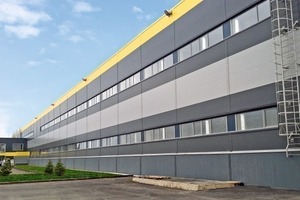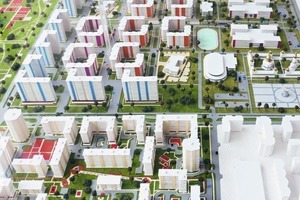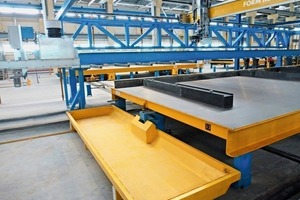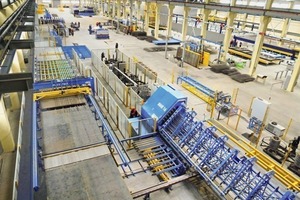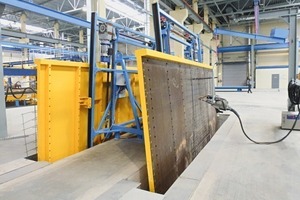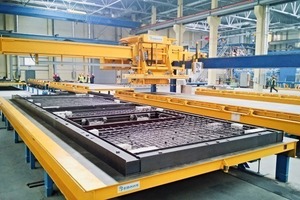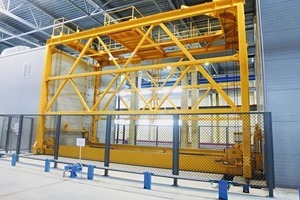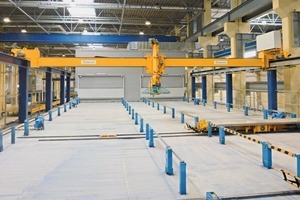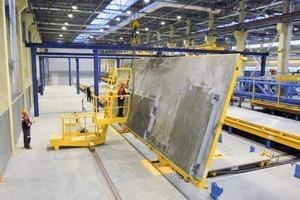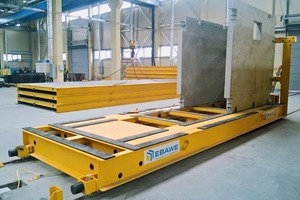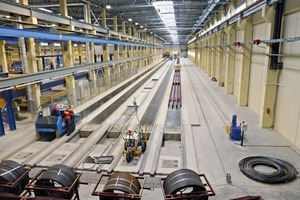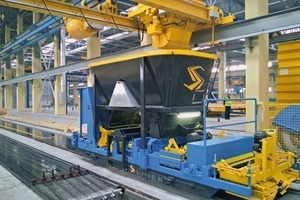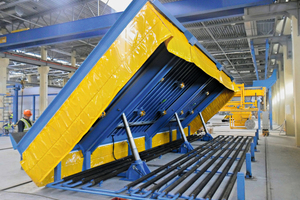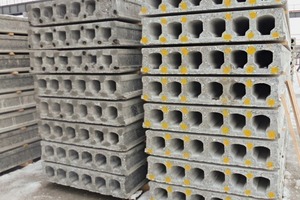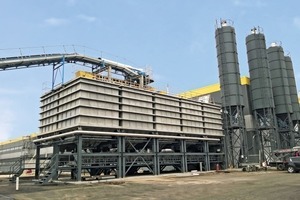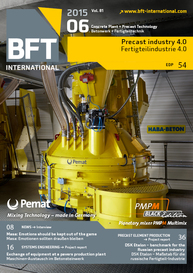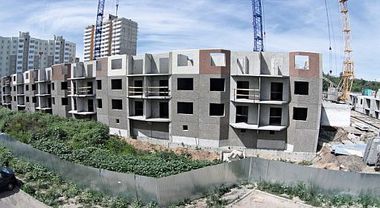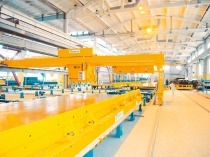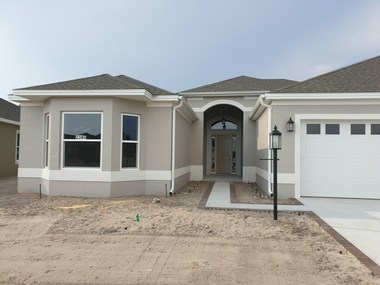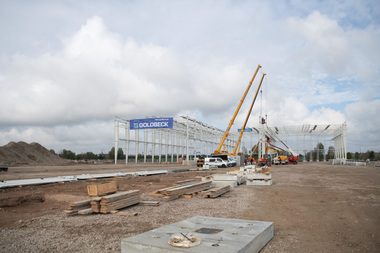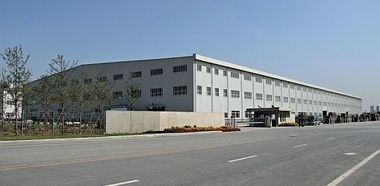DSK Etalon - benchmark for the Russian precast industry
After a construction period of slightly less than twelve months, an inauguration ceremony was held to commission a new precast plant at Ulyanovsk, Russia, shortly before the beginning of 2015. Progress Group delivered a turnkey solution to the operator, including the complete design and engineering stages as well as the entire range of equipment and machinery.
After slightly less than twelve months of construction, a grand opening ceremony was held for the new precast plant at Ulyanovsk, Russia, shortly before the beginning of 2015. Progress Group delivered a turnkey solution to the operator, including the complete design and engineering stages as well as the entire range of equipment and machinery. The total related investment amounted to 12 million euros. The new production equipment is being controlled via Ebos, a complete software suite that clearly surpasses conventional control systems because it includes process planning, production and process analysis modules. The new plant is scheduled to manufacture products for more than 200,000 m² of residential area per year.
On 23 December 2014, the commissioning of the plant was celebrated during an inauguration ceremony held in Ulyanovsk, a city with 600,000 inhabitants located about 900 kilometers south-east of Moscow. Mikhail Men, Russian Minister of Construction, Housing and Utilities, was enthusiastic about the commissioning of the new production facility. Further invitees included Sergey Morozov, Governor of the Ulyanovsk region, Nail Alimov, Chairman of the Zapad construction investment group, Natalya Butovich, Deputy Director-General of the Russian Housing Development Foundation, and management representatives of Progress Group and LiCon, the German sales agent. They jointly pressed the “Start” button of the production line to launch the manufacture of the first elements.
Russian residential development programs
for the region
Zapad, the leading investment and construction company in the Ulyanovsk region, has invested in this site to build a new precast plant on a plot owned by the Russian Housing Development Foundation. Zapad specializes in major residential development projects for the Russian population. The Ulyanovsk region actively participates in the “Housing for Russian Families” program, which aims to provide over 250,000 m² of affordable housing by mid-2017. Suitable sites, construction contractors and projects to implement the program have already been selected. The foundation launched the construction of the precast plant and supported Zapad at all project stages. The foundation’s aim is to further the development of the building materials industry and to promote the construction of new residential areas. It advocates urbanization on greenfield sites and the rehabilitation of abandoned industrial areas.
The buildings of the new DSK “Etalon” precast plant at Ulyanovsk comprise a total floor space of about 13,000 m². The company provides secure jobs to 200 employees. Its product range includes sandwich walls with integrated thermal insulation, solid partition walls, floor slabs, and prestressed concrete hollow-core floor units, as well as special precast components such as stairs and foundation piles. Produced elements will primarily be used to build apartment blocks and social facilities such as nurseries, schools and medical care centers.
Major order placed with Progress Group
All departments within Progress Group collaborated closely with each other to deliver the 12 million euro contract. Production equipment was supplied by all four engineering subsidiaries of the group: Ebawe Anlagentechnik, Progress Maschinen & Automation, Tecnocom, and Echo Precast Engineering. In this arrangement, the client benefited from a general contractor that provided a one-stop shop solution and a single point of contact, which not only reduced the client’s planning and design effort to a minimum but also favorably influenced project progress because this process eliminated the need for many of the usual complex interfaces between various suppliers and a large number of different software solutions.
The new precast plant heavily relies on automation: a robot system comprising a storage and a shuttering robot (the latter also takes care of formwork stripping) employs a fully automated process to place the forms on the pallets for the production of new elements. Formwork stripping takes place with the aid of a scanner. This solution not only reduces the amount of labor. Even more importantly, the key benefit of this automation concept lies in the high dimensional accuracy of the precast elements and, correspondingly, higher finished product quality.
Production process relies on pallet circulation
The carousel production line enables the circulation of 50 pallets that carry the precast elements in the subsequent process steps. Prior to removing finished elements, windows, doors and add-on forms are taken from the pallet manually using a handling crane. Thereafter, the pallet is conveyed to the tilting unit to enable removal of the finished wall elements vertically, i.e. in their final installation position. A mobile stair facilitates this process for the operator. The shuttering robot with formwork stripping function scans the area to be covered, identifies the forms, fetches them automatically after magnet deactivation, and places them on a conveyor that transports them to a cleaning unit.
A mobile pallet cleaning system ensures cleaning of the pallet surfaces that were previously in contact with the forms. A storage robot sorts the forms by their lengths and puts them back into storage. They are then lifted onto a conveyor to pass through the release agent spraying unit. For the new production cycle, embedded parts are drawn true to scale on the pallet surface using the robot’s plotting feature. The shuttering robot places the forms on the pallet with pinpoint precision, and the reinforcing elements previously produced on rebar machines are inserted manually.
Integrated heating system accelerates
curing process
The pallet is conveyed to the concreting station complete with the form, reinforcement and all embedded parts. The concrete spreader uses a screw system to pour the fresh concrete evenly across the pallet. In the next step, a compaction unit consolidates the first concrete layer. To remove entrapped air, the pallet is set in motion in both horizontal and vertical direction. Thereafter, insulation and reinforcement are inserted for the second concrete layer. After the second pouring step, a leveling screed accurately levels the fresh concrete surface to the required height. In this process step, the external vibrators attached to the leveling screed are used for leveling whereas its internal vibrators ensure appropriate compaction. The pallets are then moved into a pre-curing chamber for the concrete to set. After a certain dwell time, a transfer table moves the pallets onto a second level where concrete smoothing takes place. This station includes a finish blade and four smoothing units for precast element finishing. The pallets that carry the finished elements are then placed in a curing rack, which comprises four towers that provide sufficient space for 40 pallets. The curing process is accelerated by an integrated heating system.
Curetec Energietechnik GmbH & Co. KG supplied the ConCure system for the curing chambers measuring 11,000 mm x 10,000/9,000 mm x 7,500 mm. Each of the two chambers is equipped with a heating unit with an output of 205 kW/h to heat the chamber up to 50 °C through a channel system.
As soon as the elements are ready for removal, the transfer table retrieves the corresponding pallets from the rack. The exit carriage conveys the retrieved wall units – firmly held in place by transport frames – to the outdoor storage area, where they are kept for transport to the construction site.
Five 126 meter long casting beds
Prestressed concrete elements are manufactured in a separate bay of the factory building. Five 126 meter long casting beds have been set up for production, which is ensured by a slipformer and other machines such as a universal saw and a multi-purpose transfer car.
Prestressed concrete precast floor slabs in thicknesses from 6 to 40 cm can be manufactured on this production line, but this system is also used for a completely different product range, which includes floor beams, lintels, foundation piles and other items. The slipformer ensures compaction by its integrated vibration equipment and movements of the tube and mold set.
In addition, the new Ulyanovsk plant includes a stationary production system, which uses two tilt tables of 13 x 4.5 m in size to manufacture precast elements independently of the carousel line. Tilt tables are equipped with a compaction and heating system. A leveling screed with integrated finish blade ensures accurate leveling and smoothing of the concrete. The two twin forms are used to produce precast concrete stairs.
Meanwhile, business is running so smoothly that the client has ordered another two battery molds for the vertical production of interior wall units. Delivery and installation of these molds should be completed by this summer.
Mesh welding unit for reinforcing
steel production
A mesh welding unit produces mesh reinforcement just-in-time whilst ensuring highest dimensional accuracy. Ebos automatically transfers the required CAD data to the machine. To cover various other steps of reinforcement production, the new plant also includes an EBA S 12 stirrup bending machine that produces stirrups and rebar in diameters from 5 to 12 mm, as well as a ladder welding machine to fabricate straight and bent ladders from coils, a machine to process reinforcing steel from bars, and a Cage Star unit to manufacture welded reinforcement cages.
Zapad also invested in a completely new mixing system supplied by Wiggert to ensure fresh concrete delivery. This system provides the concrete volumes required for the entire product range. Another new addition is the overhead bucket line that conveys sufficient concrete quantities to the various discharge points.
Mikhail Men, Russian Minister of Construction, Housing and Utilities, was very positive about the construction of the plant and the commissioning of this state-of-the-art, high-performance production facility. “This is a highly symbolic event,” Men added to express his optimistic attitude despite difficult economic conditions. According to him, there were not exactly a lot of solutions to fall back on at times such as these. One of them, however, is the construction industry. The investment in the new plant made a major contribution to fostering the regional economy. About 1.3 million m² of affordable housing should be built by the year 2020. The team will even work in three shifts to achieve the business plan targets. Nail Alimov, Chairman of Zapad, is also envisaging delivery of finished elements to destinations outside the Ulyanovsk region.

